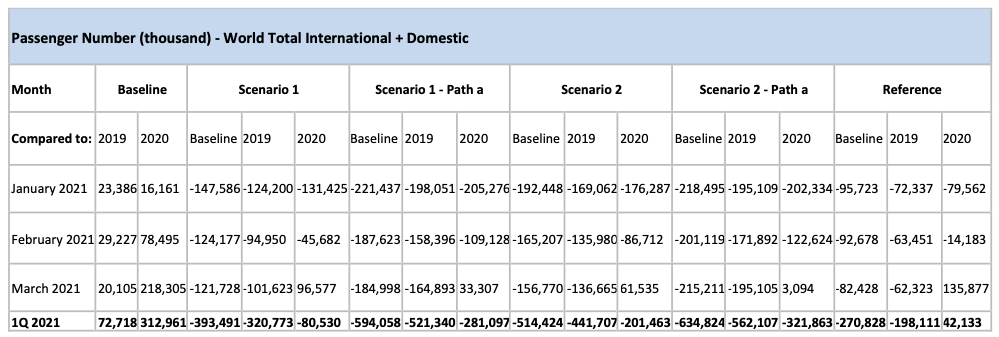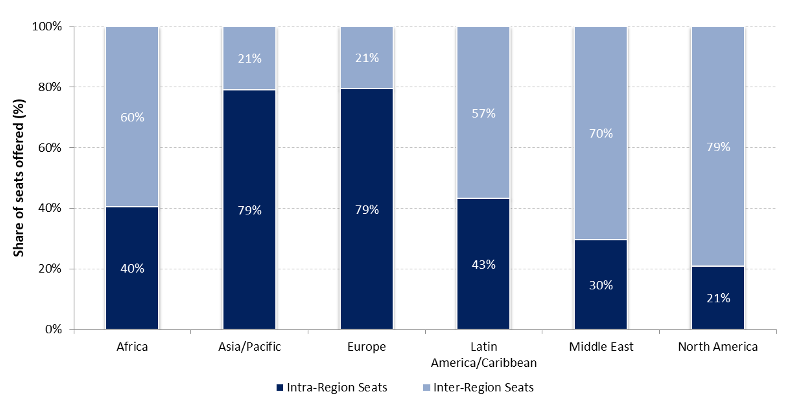Uploaded 30. September 2020 - The Economic Impact of COVID-19
On September 23rd, 2020, ICAO published a report estimating the economic impact of COVID-19 on the civil aviation industry, as well as different scenarios towards a possible recovery in 2021.
The conclusion of the report is that the COVID-19 crisis is unprecedented and its impact has already surpassed that of previous crises such as SARS, the 9/11 terrorist attacks and the 2008 financial crisis. This means that, effectively, it is as yet unknown what the recovery will look like and in what timeframe it will happen, in particular with the second peak of infections currently experienced in Europe.
The data presented in the report – and gathered from different sources – shows that the global impact of the pandemic is far-ranging:
- Airlines have seen a reduction of travelling air passengers (both international and domestic) of between 57% and 61% in 2020 compared to 2019 (source: ICAO) and a 54.7% reduction of revenue passenger kilometres (both international and domestic) in 2020 compared to 2019 (source: IATA)
- Airports have lost around 60% of travelling passenger traffic and 61% of revenues (about US$ 104.5 billion) in 2020 compared to business as usual (source: ACI)
- There has been a decline in international Tourism receipts of between US$ 910 and 1,170 billion in 2020, compared to the US$ 1.5 trillion generated in 2019, with 100% of worldwide destinations having imposed travel restrictions (source: UNWTO)
- Global trade has experienced a fall of global merchandise trade volume by between 13% and 32% in 2020 compared to 2019 (source: WTO)
- There is a projected -4.9% to -5.2% contraction in World GDP in 2020 (source: IMF and World Bank)

Due to the unprecedented width and depth of the global pandemic, it is nigh on impossible to make predictions, but ICAO has developed a number of scenarios to look at how global passenger numbers could recover in the first quarter of 2021.
These scenarios are as follows:
Scenario 1
International
Path1: Smooth capacity recovery by picking up pent-up demand but at a diminishing rate of growth.
Path1a: Capacity to start with smooth recovery but then turn back down due to over-capacity
Domestic
Path1: Swift capacity rebound pushed by pent-up demand but at a diminishing rate of growth
Path1a: Capacity to start with smooth recovery but then turn back down due to over-capacity
Scenario 2
International
Path2: Accelerating the return to trend growth after slow progression of capacity recovery
Path2a: Capacity recovery at diminishing speed due to respite and continuous demand slump
Domestic
Path2: Gradual capacity recovery, followed by the acceleration of growth
Path2a: Capacity recovery at diminishing speed due to sluggish demand growth
The model based on these scenarios as recorded by ICAO are as follows (Note: baseline refers to predictions made on a business-as-usual basis and Reference refers to airlines’ most recent expectations and is based on the latest updates of airlines schedules filed – which change weekly):
It is worthwhile noting that airlines seem to be more optimistic than the scenarios proposed by ICAO and that, if things go their way, we should see passenger numbers begin to grow again fairly significantly by the end of Q1 2021.

ICAO believes that countries with strong domestic and/or intra-regional traffic are likely to recover more quickly than those with a predominance of international routes. This is mostly due to countries having a tendency to shut down international borders but keeping domestic flights up to keep on stimulating the national economy, but ICAO also found that domestic traffic tends to be more resilient and recover faster than international traffic.
Similarly, regions with high intra-regional traffic (traffic within a region) are expected to recover more quickly than those with high inter-regional traffic, which bodes well for Europe as intra-regional seats make up a majority of seats on offer (see chart below).

The recovery will be long and, until a vaccine is developed and rolled out to people, it is impossible to make sound predictions on what the recovery may look like. But the report published by ICAO offers an insight into the trend throughout 2020 as well as possible scenarios in 2021 (the full report can be found here).

